Chicken satay from Gurney Drive, Penang
Satay
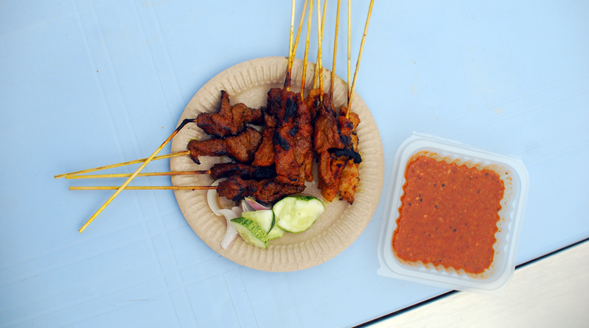

Chicken satay from Gurney Drive, Penang
This is deep-fried pieces of boneless chicken coated in a crispy shell of batter, covered in mayonnaise straight from the jar. It’s a dish that the world’s food writers conveniently overlook when they heap well-deserved praise on restaurant Tek Sen in Penang because it doesn’t fit the clean narrative of tradition or authenticity that drives the de facto view of Malaysia through the lens of food magazines. There is no clear tradition of mayonnaise in Malay-Chinese cuisine but quite clearly, there should be. Tek Sen is licensed to drive that trend.
I didn’t eat at Tek Sen the last time that I was in Penang because it was too expensive. In hindsight that looks crazy, but four years ago, I was travelling around Asia on a budget of roughly $20 a day for two including transport and accommodation. It seems like a longer time ago. Spending $10 on a single meal was a tough decision when I could graze through several bowls of laksa a day for the same price. Now I spend more than $10 a day keeping myself sufficiently caffeinated. I eat at restaurants where $10 isn’t even an appropriate tip per person. The old me is probably horrified at the new me.
Maybe that is the only sign of being a moderately functioning adult.
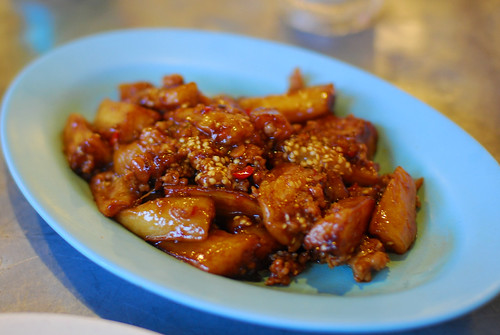
Eggplant with fermented bean paste
Four years on and the island is looking busier, more gentrified. The traffic is heavier and more Chinese shophouses are fenced off for renovation. The now World Heritage-listed core of Georgetown feels like it is beginning to take a similar path to Luang Prabang, where the centre of the city begins to hollow out for the needs of tourists, taking with it the atmosphere that tourists came for in the first place. There’s more buildings preserved as boutique hotels and the word “artisan” now attached to batik or carvings or basketry. It is still the greatest place on earth to eat on a fistful of dollars.
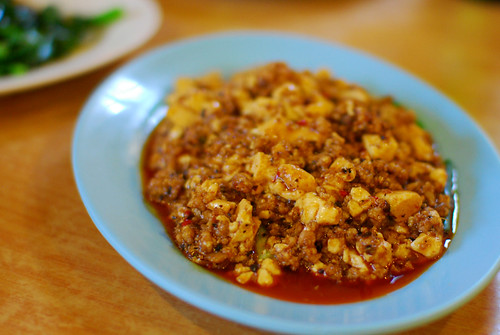
Mapo tofu has a relatively light touch of the numbing Szechuan mala sauce which lets the smoke from the wok work its way through.
Externally, Tek Sen remains much the same, a collection of reflective stainless tables encircled by battered metal stools within an airy, tiled shophouse. The menus smell like graphic design and are clearly translated into English, a small nod to gentrification.
Penang’s a different place when you’re meaningfully employed. I ate Tek Sen’s double-cooked pork on multiple occasions. The best $4 you’ll ever spend. The double-cooked pork – siew yuk – is sticky and sweet batons of pork belly, stirfried to add a dose of smoke. This is the only pork dish I’ve eaten where I’m keen to lick the thin slick of pork fat from the bottom of the plate. As much as this is the dish that drives people to Tek Sen rather than their liberal ideas about deep-frying and egg emulsions, Tek Sen has a menu where you can’t make mistakes.
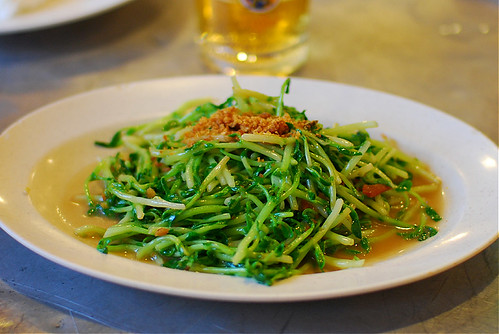
Pea shoots with dried, salted fish. It’s umami-salty and satisfying.
Eat everything. The small plates mean that even a party of two can easily work through five dishes. Four people could eat almost half the menu.
Location: 18-20 Carnarvon Street, Georgetown, Penang
You know what the average shopper at Coles Supermarket fears? Robots. Giant robots who touch their food. This secret informs their latest sleight of hand that boasts that their home delivered food is “Hand picked, hand packed and hand delivered”.
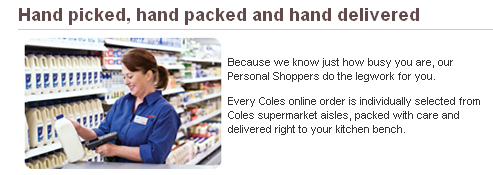
Screenshot from http://www.coles.com.au/Shop-Online.aspx/ (full page, 28 June 2012)
This was originally spotted in the wild by Harvest Feast, adorning Coles’ Tasmanian delivery vans.
Gee wonder if peeps feel special it's not MACHINE picked, packed, delivered. "Hand picked" off shelves, wow! #CrapFiles pic.twitter.com/gsbQdq7p
— Harvest Feast (@HarvestFeast) June 27, 2012
Coles’ food is however, picked and packed by giant robots at some point in its journey from factory to you. Here’s the video of that happening:
SSI Schaeffer, who installed the systems, are quite proud of their achievements. From their press release:
Automated picking solutions at Coles’ two national distribution centers align with the companywide strategy to deliver store-ready stock more efficiently. Supply Chain Review goes inside the Melbourne facility to inspect the world-class system. At least part of the supply chain transformation of supermarket giant Coles is being handled not by people, but by robots. Automated picking solutions at Coles’ two key national distribution centers (NDCs) in Sydney and Melbourne are, according to the retailer, providing significantly improved store-friendly deliveries while minimizing end-to-end supply chain costs and making warehousing operations safer and more efficient.
(emphasis is mine)
Moreover, almost all of the processed food that goes into Coles’ deliveries was picked and packed by robots (or at least, some automated system) at the original manufacturer. So why the sudden bout of robophobia from one of Australia’s supermarket duopoly?
Welcome to the coopting of handmade. Western luxury is no longer defined by owning perfect objects but by having the time to select pieces that display the tell-tale imperfections of the human hand. It’s what you probably stare longingly at on Pinterest. Just like “artisanal” before it, now well dead and obituarised by The Atlantic, major corporations now battle to appear as if real humans touched their things and by doing so, render the terms meaningless.
I’m no longer certain whether any of these terms are redeemable, but at the very least, we can point out the most egregious of lies.
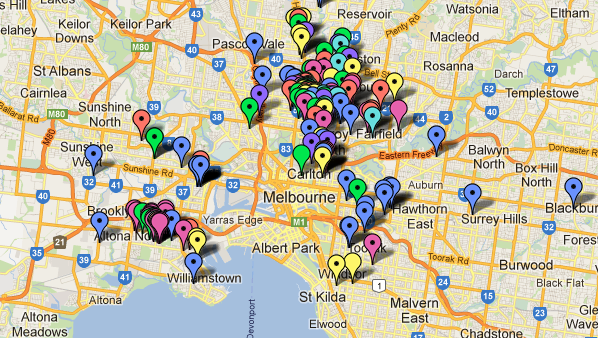
Here’s a community built map of overhanging fruit in (mostly) Melbourne. Not much will be in season at the moment apart from the lemons, so hold off a few months before you selfishly plunder the neighbourhood trees.
View Neighbourhood harvest in a larger map
My favourite Mexican cookbook is Marilyn Tausend’s Cocina De La Familia because it is not devoutly Mexican. Tausend isn’t Mexican and collated her recipes from interviews with home cooks across America rather than in Mexico. Recipes come with the location that they were collected and the Mexican state where the recipe or cook originated. It captures the evanescent nature of immigrant food; the adaptations and innovation required from living somewhere other than home and cooking for the eternally-shifting tastes of Americans that at some point in the past came from Mexico. It says “authentic” on the cover but it is an uneasy label for a book that documents a cuisine that has thoroughly changed from an imaginary state of origin south of the border.
I like it because it gives Mexican-Americans a huge amount of credit and agency for adapting traditional recipes. Cooking nachos is given equal importance to cooking a more traditional looking sopa. The emphasis is on delicious rather than time-honoured.
With the current flood of Mexican restaurants opening across Melbourne, the laziest way to deride them is decry their lack of authenticity, ticking off your personal list as to whether they serve corn smut or cabeza or whatever other edible markers of tradition apply, making an assiduous note of the ethnicity of the chef. As soon as that happens, you deny that food and culture are mutable, and shifts to accommodate the locals.
Recently, Gustavo Arellano took this up in an interview in the New York Times.
But he is wary of the many non-Mexicans who have anointed themselves as ambassadors for Mexican food in the United States, from Bertha Haffner-Ginger (who taught cooking classes at The Los Angeles Times in the early 20th century and wrote an influential and confusing cookbook called “California Mexican-Spanish Cook Book”) to more modern arbiters of taste like the British expatriate Diana Kennedy and the Chicago chef Rick Bayless.
For Mr. Arellano, non-Mexicans who glorify “authentic” Mexican cuisine, even with respectful intent, are engaging in a kind of xenophobia. “It’s a different way of keeping Mexican food separate, out of the American mainstream,” said Mr. Arellano, who calls Mexican-food purists “Baylessistas.”
Arrellano has excellent form – his now decade old column “Ask a Mexican” in the OC Weekly pokes into the recesses and excesses of Mexican-American culture, often to hilarious effect. To underline his idea of authenticity: he’s a man who takes a great deal of joy in what happens when you translate Vietnamese food for a Latino clientele rather than seeing it as a culinary abomination.
To Arrellano (and me), food is more interesting where cultures butt heads and I can’t imagine a situation more interesting than watching what happens in Melbourne where the previous culture of Mexican food that was wrapped up in the yellow box of an Old El Paso meal kit runs into the current one that seems to revere the taco truck of Roy Choi rather than the markets of Oaxaca.
He still puts on a white linen suit every morning, rides in a chauffeured white Cadillac, visits Kentucky Fried Chicken’s white column headquarters and plugs his “finger lickin’ good” chicken around the country.
But Harland D Sanders, everyone’s favourite Kentucky colonel, is disturbed about what has happened to his chicken and to America’s dining habits.
While it sounds like an alternate history from Adbusters archives, it’s from an interview with Sanders in The Milwaukee Journal, 1975. You know something has gone terribly wrong with food when the mascot starts decrying it.
Since the City of Melbourne passed an edict that no new restaurant can get a liquor licence in Melbourne unless it serves a fish taco, my Melbourne restaurant name generator has become redundant. I’ve been meaning to write some reviews, but most of the new joints do a pretty good job of satirising themselves. So inspired by this tweet from Beechworth chef Michael Ryan, here’s a Mexican edition of the restaurant name generator. Name that new restaurant:
‘;
print “$text”;
print ‘
‘;
print ‘
“;
?>
Press reload for more authentic Mexican suggestions. Also, inspired by my original generator, Willamette Week in Portland has made a local version.
I’ve just released a new bot into the wild, who invents a new name for a Melbourne restaurant twice a day, just like the Melbourne Restaurant Name Generator but delivered directly to the loving bosom of your twitter feed.
Follow it for regular, nonsensical updates.